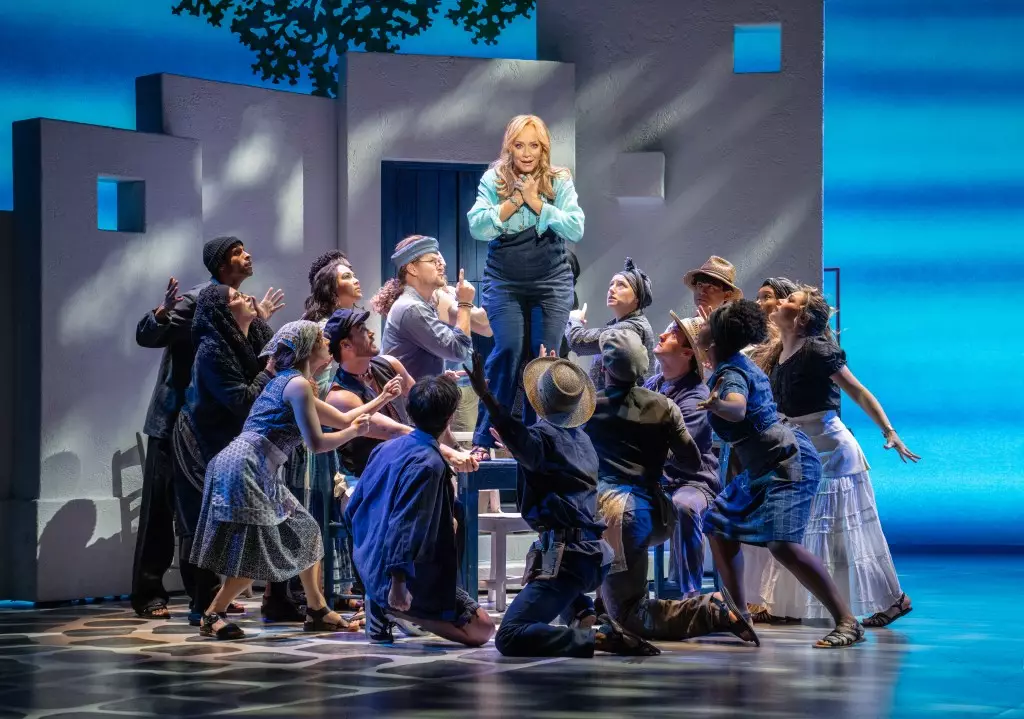Despite the general downturn plaguing Broadway’s box office numbers last week, the debut of *Mamma Mia!* provided a rare beacon of optimism in an otherwise sluggish scene. Selling out its initial preview at the Winter Garden Theatre and grossing nearly a quarter of a million dollars in just one night, this revival signals more than just a nostalgic return; it embodies the persistent allure of proven entertainment formulas amid economic and cultural headwinds. While many productions grapple with dwindling audiences and economic setbacks, *Mamma Mia!* defies the norms, leveraging its iconic status and familiar tunes to attract loyal fans and curious newcomers alike.
Reviving Classics: A Strategic Gamble
The decision to bring back *Mamma Mia!* is a calculated move rooted in recognizing the timeless appeal of well-loved musical theater properties. Its prior success—running for over a decade and a half, setting records at the Winter Garden—demonstrates that audiences crave comfort and familiarity even as the world changes rapidly. This strategy contrasts sharply with the tendency to chase new, often riskier, productions that struggle to find footing amid high costs and uncertain demand. The revival’s limited six-month run suggests a savvy logistical choice, aiming to capitalize on nostalgia while avoiding overextension in a market that is increasingly risk-averse.
The Broader Ecosystem: Winners and Strugglers
While *Mamma Mia!* set the tone with a strong start, it’s crucial to view its performance within the broader landscape of Broadway. The week’s other major hits—*Hamilton*, *Wicked*, and *The Lion King*—continue to solidify their status by filling seats and generating impressive revenues. Yet, this success is juxtaposed against the struggles of shows like *Call Me Izzy* and *Gypsy*, which continue to operate below optimal capacity. This divergence underscores a larger truth: Broadway’s vitality now hinges less on the quantity of productions and more on the selectiveness and resilience of its marquee titles.
The Economic Reality and Ticketing Dynamics
Breaking down the financial data reveals a nuanced picture. Despite some shows grossing over a million dollars, the overall industry experienced a modest decline of 5% week-over-week. Average ticket prices—$126.86 across the board, soaring up to over $231 for premium shows—highlight an industry trying to balance profitability with accessibility. This approach is double-edged; higher prices can deter casual patrons, yet they also sustain the financial health of the most prominent productions. The fact that *Mamma Mia!* opened at a premium level indicates a willingness among audiences to pay for familiarity and nostalgia, which may be a strategic lifeline in turbulent times.
A Tipping Point for Broadway’s Future
While the numbers appear modest—total gross bookings of around $30 million and attendance dipping slightly—there’s an undercurrent of resilience rooted in strategic adaptation. The upward trend in season-to-date gross revenue shows that, despite challenges, Broadway remains a cultural and economic force. However, the critical question is whether this resilience can be maintained as costs escalate and audience preferences evolve. The industry’s future hinges on striking a balance: leveraging reboots of beloved classics like *Mamma Mia!*, while innovating in ways that recalibrate expectations and foster sustainable growth.
Center-Right Perspectives: Navigating the Cultural Economy
From a center-right liberal standpoint, the ongoing revival underscores the importance of pragmatic conservatism—cherishing cultural traditions while encouraging responsible innovation. Broadway’s success increasingly depends on safeguarding its core assets—timeless musicals and iconic shows—while fostering an environment where new productions can take calculated risks without jeopardizing overall stability. The resurgence of *Mamma Mia!* exemplifies how strategic investment in proven hits can stabilize an industry that is indispensable both culturally and economically. Yet, it also calls for careful stewardship, ensuring that ticket prices and accessibility do not alienate the very audiences that sustain it. Supporting this approach can help Broadway maintain its position as a resilient pillar of cultural commerce, adjusting to modern challenges without forsaking its heritage.
Despite the current setbacks, the pattern emerging suggests that Broadway’s strength lies in its ability to adapt—reviving hits, controlling costs, and responding to audience preferences with precision. As long as the industry remains anchored in pragmatic choices rooted in cultural appreciation and economic foresight, Broadway will continue to be a vital part of the city’s identity and a beacon of entertainment value.

